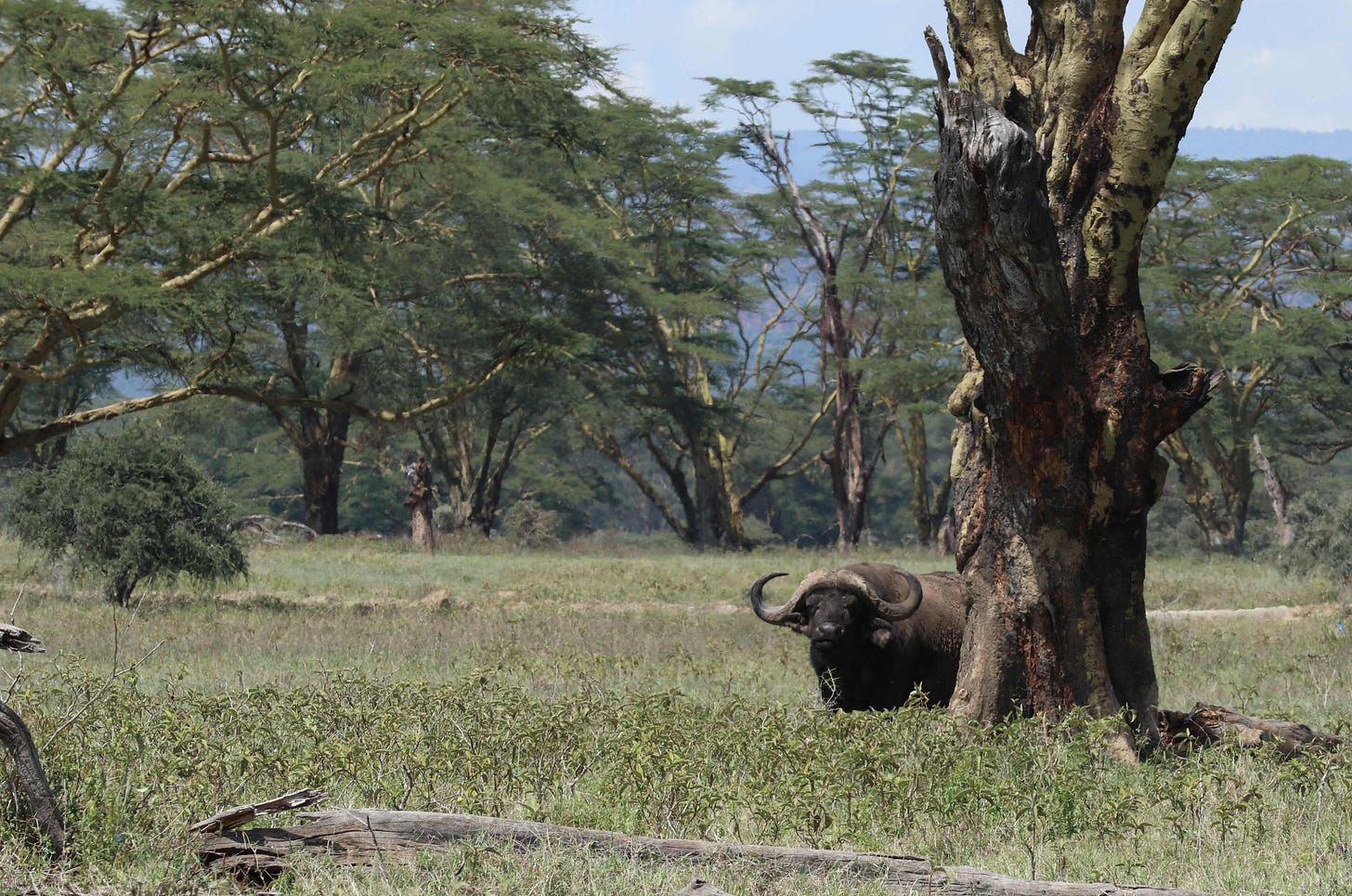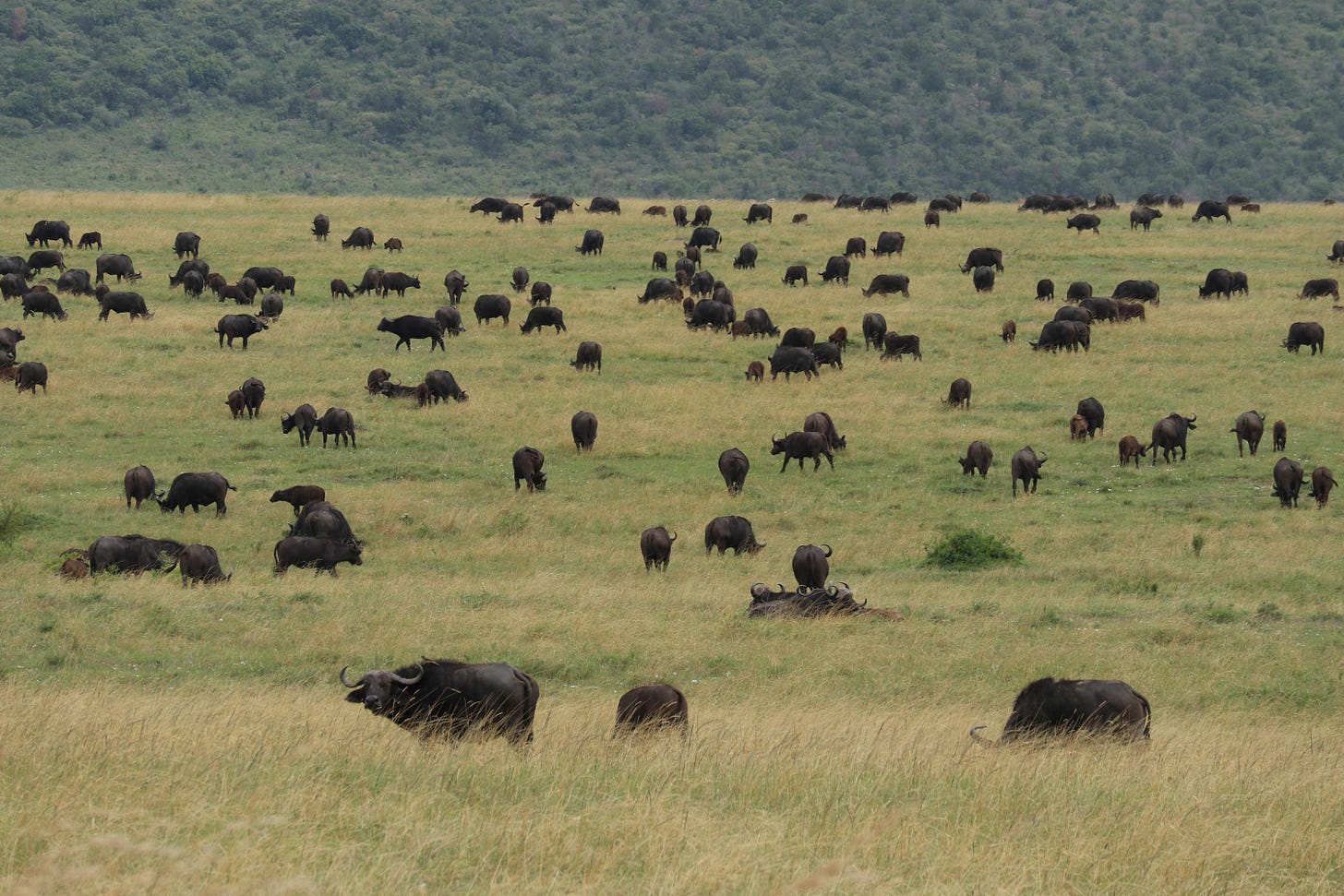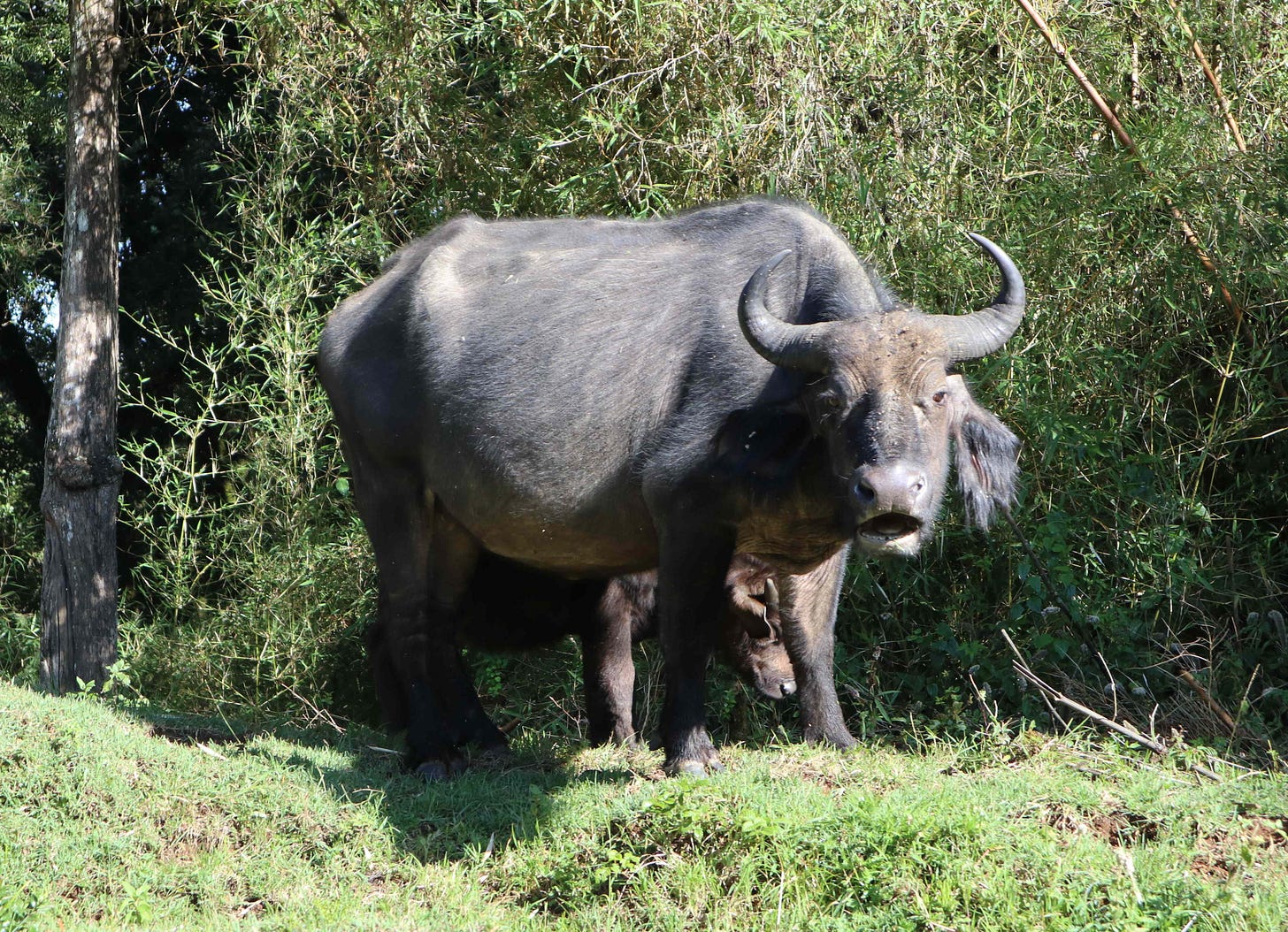Desperate measures
Two dreaded animal diseases, two different vaccines, two different results (12 minute read)
When I was a child, I had a wide range of interests, most of which were considered obscure by other children and adults. I wanted to work with insects from the time I learned the word entomologist. My favourite insect was the giant wētā – not that I’d ever seen one because they were confined to remote offshore islands, but I read everything I could about them and knew all the different types. I could name half a dozen Baroque composers but no pop groups. I used to get books on mushrooms and toadstools from the library and attempted to identify the ones I found in my garden.
I have a particular memory from when I was twelve, when all the girls in my class (it was a single-sex school) had to choose a topic, make a poster about it and give a talk. I don’t remember what the other girls did, apart from one who had been on holiday in New Caledonia and gave a talk about Club Med. I decided to talk about foot and mouth disease of livestock. I have no idea why, but clearly my interest in biosecurity developed young. I do remember that after my talk the only thing the teacher said was you won’t make a teacher. I had no intention of becoming a teacher, but the criticism still stung.
Foot and mouth disease is on my mind because I’ve been looking for case studies of decision making in biosecurity which can be used in training. I’ve been using examples from outside New Zealand so that I’m not using situations which people here have been directly involved in. Foot and mouth disease is a useful case study, because there have been a couple of well-documented outbreaks in Britain. Although it’s never reached New Zealand, it’s well-known among people who work on biosecurity here. For many of my former colleagues, it’s their worst nightmare, and they have put a great deal of effort into ensuring that it doesn’t get here. And, just in case, they have also planned for what to do if it does arrive.
I had other topics I wanted to write about this week, but I don’t feel I’ve got the space in my brain. So, I’m looking at foot and mouth disease, and another livestock disease, known as rinderpest, which makes an interesting contrast.
Foot and mouth disease is caused by a virus which infects cloven-hooved animals – cattle, sheep, goats, pigs, but also deer, alpaca and other species of wildlife. It doesn’t usually infect animals which aren’t cloven-hooved, such as horses. However, there are a couple of exceptions, such as capybara, a type of rodent, and possibly hedgehogs. Most sources say it can’t infect humans, but it can, just very infrequently and apparently only from close contact with infected animals (although it’s so rare that not much is known). There is a report from 1836 when three vets caught the disease by drinking raw milk from infected cows, something that they did intentionally, presumably to test theories about the transmission to humans. At least they tested it on themselves, I suppose.

Although the rare human cases of foot and mouth disease are mild, it’s painful and debilitating to animals like cattle and pigs. It causes blisters in the mouth and on the feet, as the name suggests, and often kills younger animals even before they show symptoms, by attacking their hearts. It rarely kills adult animals, but they can remain infectious for months, or sometimes years. Cows may never fully recover.
It’s so dreaded among farmers, vets and government agriculture officials because it’s an extremely contagious disease. Once one animal in a herd catches it, it spreads quickly to the others, often infecting every animal. As well as spreading by direct contact between animals, it can be spread through milk and meat (for example when pigs are fed food waste) or through contact with contaminated equipment, footwear or soil. The virus is not killed by pasteurisation of milk and can survive in meat, although this depends on the type of meat and how it is processed.
The virus also travels through the air. This is probably the thing which most terrified me when I read about it as a child. For a disease such as COVID-19, spread through the air has been documented in terms of metres, perhaps as much as 15 metres. For foot and mouth disease, there have been outbreaks which travelled tens of kilometres, and a couple of cases where it travelled hundreds of kilometres. One important factor for spread through the air is the type of animal infected. Pigs shed particularly large amounts of the virus, so an outbreak in a pig farm is particularly likely to result in long-distance spread through the air.
The foot and mouth virus can travel a long way on the wind, but it isn’t going to blow to New Zealand. (There are plant diseases which have blown to New Zealand from Australia, but that’s something I’m going to write about later, after I’ve visited Northland.) Just as with COVID-19, our isolation gives us a real advantage when it comes to keeping livestock diseases out of New Zealand. Farmers, scientists and politicians quickly recognised this, and the first law on livestock quarantine was passed in 1849. The Diseased Cattle Act of 1871 specifically named foot and mouth disease. The law prohibited the import of cattle from regions with the disease.
In those days, international transport was a slow and difficult business. Animals could be transported alive, with some difficulty, but any animal products moved around the globe had to survive months at sea, at whatever temperatures the ship was experiencing. Meat had to be tinned or heavily salted to survive. That changed in the late 1870s, with the development of refrigerated shipping. In 1882, the first consignment of frozen lamb was transported from New Zealand to Britain.
I haven’t been able to figure out whether the global meat trade which developed with refrigeration resulted in the increased spread of foot and mouth disease. It is unlikely to have increased the risk to New Zealand, because we were meat exporters rather than importers. The disease was spreading at this time, though. It was entrenched in Europe and causing outbreaks in North America, South America, Africa, Asia and Australia. The origin of foot and mouth disease isn’t clear from the papers I’ve read, but it does appear that it reached these places with European colonists and their livestock.
The spread of foot and mouth was definitely of concern to farmers and to governments at that time, because some countries were making considerable efforts to control it. Australia hasn’t had an outbreak since 1872, and the USA since 1929, while until the year 2000, Japan hadn’t had an outbreak since 1908. However, foot and mouth wasn’t the most feared livestock disease at this time. New Zealand was more concerned with a disease named pleuropneumonia, a disease of cattle caused by bacteria. It doesn’t spread as easily or as fast as foot and mouth disease, but under some conditions can kill up to 90% of the cattle it infects. In New Zealand, the Diseased Cattle Act of 1861 named pleuropneumonia as its target – ten years before the act mentioned foot and mouth disease.
There was, however, a disease of cattle which was worse than either pleuropneumonia or foot and mouth. It was known as cattle plague, although today the German name for the disease, rinderpest, is most often used. It’s caused by a virus which is closely related to the measles virus in humans. In fact, measles is thought to have originated when rinderpest jumped into humans, perhaps as recently as 1000 years ago.
Like measles, rinderpest, spreads easily and quickly. It doesn’t travel the vast distances that foot and mouth can, but can spread 100 metres through the air under some conditions. It’s also a much more severe disease than foot and mouth. It commonly kills 80% of infected animals, and severe strains can kill all infected animals, although there were also mild strains with lower fatality rates.
Outbreaks in Europe were so severe that in the early 18th century the pope asked his personal physician, Giovanni Maria Lancisi, to investigate the disease. Lancisi advocated killing and burying infected animals, as well as restrictions on moving cattle from place to place. His methods attracted some opposition, and seem brutal, but with a disease as devastating as rinderpest that is probably the most humane approach. In the end, his methods worked.
Lancisi was one of a number of physicians in Italy who were working on rinderpest and coming to a greater understanding of infectious disease. They rejected astrological explanations for the disease and proposed that tiny animals were responsible. They valued measures to control infection, such as cleanliness and isolating the sick. One of the physicians, Carlo Francesco Cogrossi, explained what he considered to be a prudent approach to disease management: “Do not fail to make use of divine measures as if human ones were lacking, and of human ones as if divine ones were lacking”. Lancisi advocated for veterinary medicine as a distinct branch of medicine, and his work directly contributed to the founding of the first veterinary school, in Lyons, France.
Despite the efforts of physicians and then vets, rinderpest remained a serious problem. In the middle of the 19th century, Europe lost most of its cattle to the disease. Then the disease reached Africa in the 1890s, with catastrophic consequences. Not only did rinderpest kill most of the cattle, it caused famine among people who depended on cattle for survival. One third of the people in Ethiopia died as a result, and there were similar tragedies elsewhere. Wild relatives of cattle, including wildebeest, buffalo and eland were also killed in huge numbers, altering the savanna environment. Europe saw a resurgence of the disease in the 1920s, again losing huge numbers of cattle. The outbreak resulted in a massive disruption of food production and famine, because as well as killing beef and dairy cattle, it killed the oxen used for pulling carts and ploughs.
Despite the destruction caused by the disease, unless, like me, you have a particular interest in historical plagues, the chances are you’ve never heard of rinderpest. Why should this be, when it was so much more severe than the more well-known foot and mouth disease? The observant among you may have noticed a clue in my words. I have been referring to rinderpest in the past tense.
The last known case of rinderpest was in a buffalo in Kenya in 2001. Ten years later, the disease was declared eradicated. It was the first animal disease to be eradicated, and only the second disease ever, after smallpox. How was it eradicated? Basically, the same way as smallpox, by a massive vaccination campaign. The vaccines developed against rinderpest gave lifelong immunity and were heat-stable, making them easy to store and transport.

But before it was eradicated, rinderpest led to something else. The disastrous outbreak in Europe in the 1920s, which resulted from the international movement of live cattle, made vets realise that international cooperation was needed to control animal disease. In 1924, a group was established by the name of the Office International des Epizooties, or the OIE for short (the word “epizootic” is the animal equivalent of epidemic). It was (and is) based in Paris, hence the French name, although it has now changed its name to the World Organisation for Animal Health. It is celebrating its centenary this year, which is one reason I wanted to write this article.
As well as rinderpest, the group identified eight other diseases of concern, including rabies, anthrax, pleuropneumonia, and foot and mouth disease. However, it hasn’t yet repeated the rinderpest success with these other diseases. Why not? There’s a reason for each disease, but foot and mouth makes a particularly interesting comparison.
I’m sure that many of you reading this will remember hearing about the 2001 foot and mouth outbreak in Britain. The images of burning pyres of cattle are still vivid in many people’s minds. The outbreak lasted seven months, and by the time it was over six million animals had been killed. I can’t imagine how horrible it must have been for those involved, particularly the farmers. But because it was seen as an animal problem, authorities were slow to recognise the toll on people.
But why was vaccination not an option? And why did so many animals need to be killed when the disease itself is rarely fatal?
There are vaccines for foot and mouth disease, but there are several problems with them. The first is that they don’t give lifelong immunity like the rinderpest vaccine does. New Zealand couldn’t simply vaccinate livestock just in case foot and mouth arrived. We would need to do it again and again, every few months, on the remote chance that the disease came in. The second problem is that there are seven different types of foot and mouth disease, and a vaccine would be required for each one. In contrast, there is only one type of rinderpest, even though within that type there is considerable variation. The third problem is less of an issue for New Zealand, which has well-developed infrastructure, but foot and mouth vaccines need to be kept cool, so they are difficult to use in remote areas.
So, when an outbreak occurs, vaccines can be used to slow the spread of the disease, but they aren’t routinely used. But, even with vaccines, foot and mouth can still spreads far and fast on the wind. So far, the disease has proven unmanageable if infected animals are left in their fields, or even indoors, for the week or so they are infectious.
There’s another problem too, more political than technical. The tests commonly used to diagnose foot and mouth disease aren’t good at distinguishing between an animal which is infected with the virus and an animal which has been vaccinated. Countries which can demonstrate that they are free from foot and mouth, such as New Zealand, have far fewer restrictions placed on the animal products they export.
Better vaccines are coming, especially with the lessons learned from developing Covid-19 vaccines. Better tests are being developed too. But, until better vaccines and tests are available, we need to rely on strict border measures to keep the disease out. These measures aren’t simply about frontline staff checking passengers and cargo, although this is important. They depend on developing robust standards, based on rigorous risk assessments. They depend on negotiating with exporting countries and verifying that their systems are effective. We depend on numerous “back office” staff with years of expertise to keep our country safe.






Wow -- I'd never heard of rinderpest, and now I know why! I also had no idea there are 7 types of foot and mouth disease. Thanks for the informative article, and especially for all the great pictures!
Hi Melanie - timely article for us at AgResearch as we review biosecurity research priorities - animal diagnostics and other aspects of animal biosecurity are getting renewed attention - the belief being that contributions can lead to improvements. Your writing has elevated to the level of art-form - and for me the communication style is clear - much as you'd hope a teacher would provide.